November 2024

The global MRI (Magnetic Resonance Imaging) market size was estimated at US$ 6.65 billion in 2023 and is projected to grow US$ 12.51 billion by 2033, rising at a compound annual growth rate (CAGR) of 6.52% from 2024 to 2033. It is anticipated that rising disease prevalence will have a significant impact on market expansion.
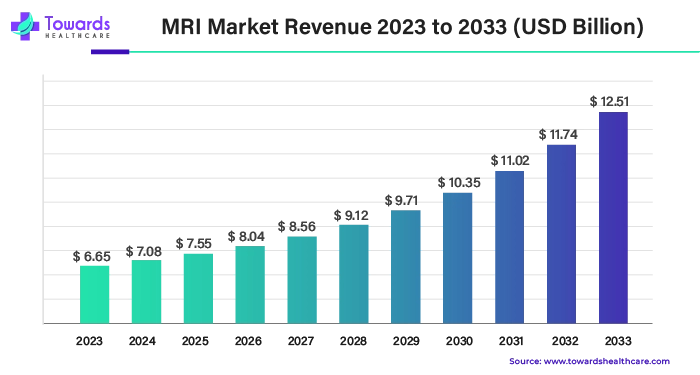
Almost all internal human structures, including the organs, bones, muscles, and blood arteries, may be seen in great detail with magnetic resonance imaging, or MRI, a noninvasive medical imaging procedure. A powerful magnet and radio waves are used in MRI scanners to produce pictures of the body. In the field of medicine, the invention of the MRI scan is a significant turning point. The magnetic resonance imaging system is essential for the early diagnosis of many tumors, traumas, malignancies, and liver, renal, bone, and tissue illnesses all over the world. Continuous expenditures in developing the market result in an increase in market size and share due to the increased demand for magnetic resonance imaging. With MRI market structures expected to increase significantly over the projected time, these elements will thus aid in improving them quickly.
The MRI market ecosystem is composed of several critical components that work together to provide advanced imaging solutions. At its core, the market includes MRI scanners, which are the primary devices used to capture detailed images of the body's internal structures. These scanners come in various types, including closed, open, and extremity MRI machines, each serving different patient needs and clinical applications.
The MRI market ecosystem is supported by companies specializing in several areas. MRI scanner manufacturers such as Siemens Healthineers, GE Healthcare, and Philips Healthcare produce a range of MRI machines with varying capabilities, from high-resolution imaging to specialized features for specific medical conditions. These companies invest heavily in research and development to advance MRI technology, enhancing image quality, speed, and patient comfort.
In addition, companies like Toshiba Medical Systems and Canon Medical Systems contribute by providing maintenance, support, and service solutions for MRI machines, ensuring their optimal performance and longevity. Furthermore, software providers like Brainlab and Medtronic enhance MRI functionality through advanced imaging software and integration with other medical technologies.
Together, these components and companies form a comprehensive ecosystem that drives innovation and improves diagnostic accuracy in the MRI market.
| Company Name | Siemens Healthineers |
| Headquarters | Erlangen, Germany |
| Recent Development | In May 2024, the behemoth in medical devices, Siemens Healthineers, revealed plans to invest $250 million in a new production facility in the UK to produce superconducting magnets for use in Magnetic Resonance Imaging (MRI) equipment. According to Siemens Healthineers, the North Oxfordshire plant will generate over 1,300 employees in the region and reduce the amount of finite and non-sustainable resources, like helium, used to create MRIs. With the use of what the business calls DryCool technology, the facility will house the first MRI scanner in the United Kingdom. This technology decreases the quantity of helium needed in an MRI scanner from 1,500 liters to less than one liter. |
| Company Name | Fujifilm |
| Headquarters | Tokyo, Japan |
| Recent Development | On March 2 and 3, 2024, during its CT & MRI User Conclave held at Hotel Novotel in Mumbai, FUJIFILM India, the premier provider of comprehensive healthcare imaging solutions, unveiled its newest state-of-the-art Echelon Synergy MRI machine. This industry gathering called the CT & MRI User Conclave, is put on by FUJIFILM India with the goal of fostering excellence in the radiology sector by investigating the future of CT and MRI technology. |
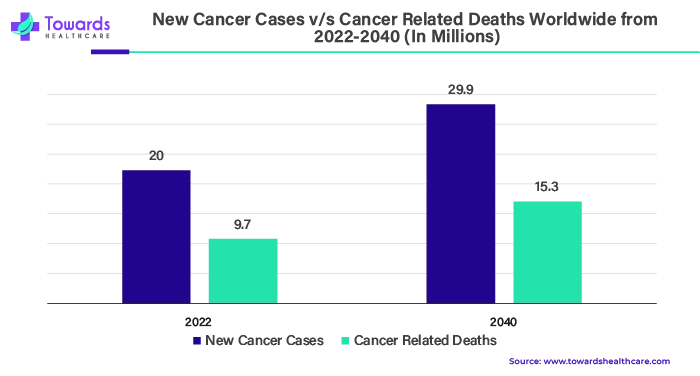
The WHO estimates that there will be 9.7 million cancer-related deaths and 20 million new instances of the disease in 2022. 53.5 million people were predicted to still be alive five years after receiving a cancer diagnosis. Cancer affects 1 in 5 persons at some point in their lives. The illness claims the lives of about 1 in 9 males and 1 in 12 women. Lung cancer accounted for 2.5 million new cases globally, or 12.4% of all new cases, making it the most frequent cancer. Next in order of incidence was colon cancer (1.9 million cases, 9.6%), prostate cancer (1.5 million cases, 7.3%), stomach cancer (970,000 cases, 4.9%), and female breast cancer (2.3 million cases, 11.6%).
Furthermore, MRI aids in the detection of issues, including cancer. It is highly effective in identifying and locating specific forms of cancer, and it may detect tumors that could or might not be cancer. Sometimes, doctors can determine if a tumor is cancerous or not from the MRI pictures. However, more testing (such as a biopsy) may be required to determine if a tumor is cancerous or not. Additionally, an MRI can search for indications that a malignancy has migrated beyond its initial site of genesis. Medical professionals can better plan cancer treatments such as radiation or surgery when they have access to MRI results.
A technical charge, professional fee, and facility fee are among the several expenses that make up the entire cost of an MRI scan. An MRI might require anything between $150,000 and $3 million worth of equipment. To prevent interference from other medical imaging examinations occurring within the facility, a specially designed room has to be constructed. An MRI room can cost as much as $5 million after setup and installation. An MRI scan will cost more money at a hospital. In order to pay for additional costs that outpatient imaging clinics do not incur, many hospitals may raise the cost of an MRI.
With the aid of a promising new AI technique created by Monash University engineers, a 5-minute full-body MRI scan could soon become a reality. Researchers have demonstrated how their unique artificial intelligence system, McSTRA, beat cutting-edge techniques in a study published in Computers in Biology and Medicine. McSTRA produced superior clinical imaging at record speed. Depending on the size of the region being examined, an MRI scan may take up to 60 minutes. With the ability to complete scans ten times quicker than existing MRI equipment, the new software might cut scan durations down to just a few minutes, increasing the number of patients who can receive diagnostic services. The researchers anticipate that if additional validation of the approach is fruitful, manufacturers will include it in MRI equipment of the next generation for use in clinical settings.
For instance,
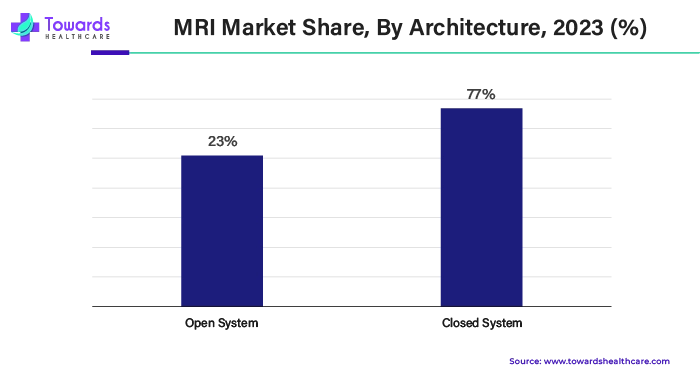
The closed MRI system segment held the largest share of 77% in 2023. Compared to an open MRI, a closed MRI is more recent and uses a capsule-like area where patients recline to receive high-quality pictures. Depending on the body area the doctor wants to scan, they can typically scan more quickly due to the intensity of the magnetic field. However, it may still take some time. A notable advantage of closed magnetic resonance imaging (MRI) is its ability to get detailed, high-quality pictures due to a greater magnetic field. At the same time, there are numerous imaging needs where 1.5T is suitable; a 3.0T greater magnetic field aids in the precise detection of circumstances like the following.
The open MRI system segment is estimated to grow at the fastest rate of 23% during the predicted period. These have an open design with a magnetic bottom and top, lowering the chance of claustrophobia and panic attacks significantly. You can also utilize an MRI to correctly analyze your condition. These do not contain capsules. You may be considerably more comfortably accommodated by the system, regardless of your size. Over time, as medical technology has improved, open magnetic resonance imaging (MRI) systems have gained popularity and sophistication over closed ones. Doctors can keep up with the most recent developments in the MRI market with the aid of open MRI systems.
For instance,
The mid-field strength segment held the dominant share of more than 49% in 2023. In addition to using less energy and space, mid-field MRIs may be easier to access. There are several benefits to using mid-field MRI despite its much lower field strengths than conventional MRI. One possible benefit is that it might make MRI technology more widely available to anyone in need. Hospital rooms must be equipped with specific plumbing in order to accommodate the large, costly, and conventional MRI machines. This is not necessary for mid-field MRIs. When it comes to bringing them out into the community, they can even be used on the truck's trailer.
The high-field segment is estimated to grow at the fastest rate during 2024-2033. Magnets with the highest picture quality, which is regarded as "standard," are high-field MRIs. They operate at 1.5 or 3.0 Tesla. When a patient lies down in a magnet, the cylindrical structure produces a longitudinal axis aligned with its horizontal magnetic field, giving the magnet a linear shape.
The brain and neurological segment held the largest share of 24% in 2023. Among imaging tests for the head, and especially the brain, magnetic resonance imaging (MRI) is now the most sensitive when compared to CT (computed tomography) scans and X-rays. More precisely, an MRI of the skull or brain can reveal any abnormalities in the surrounding tissues or brain. Since MRI provides a clearer image of the brain than other imaging procedures, it is frequently used to identify brain cancers.
For instance,
The breast segment is expected to grow significantly during the forecast period. When coupled with breast ultrasonography and mammography, MRI can be a helpful diagnostic technique. MRI can detect certain tiny breast abnormalities that mammography may miss, according to recent research. Additionally, women with breast implants and younger women who often have thick breast tissue may benefit from its assistance in the detection of breast cancer. Elevate the number of yearly screenings for women at high risk of breast cancer by using magnetic resonance imaging (MRI), as it does not require radiation to check those under 40.
For instance,
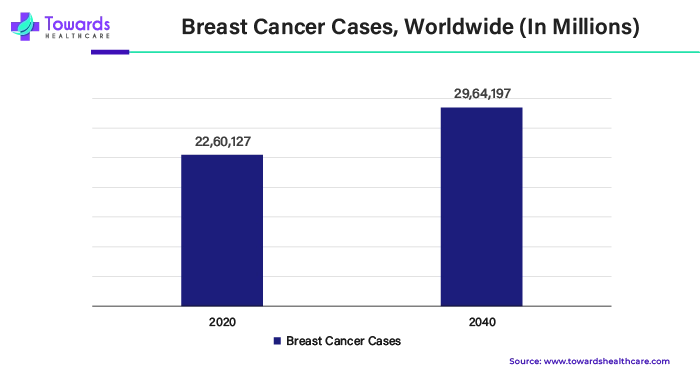
The hospital segment dominated the MRI market in 2023. Because hospitals often have larger, more specialized medical facilities and technology than clinics or other types of medical settings, MRI is frequently used in hospitals. Hospitals can afford to invest in this cutting-edge technology, but MRI scanners are expensive to buy and operate. Furthermore, hospitals usually have a larger pool of experts and support personnel who can analyze the findings and offer the right treatment after an MRI scan. Hospitals are an ideal fit for MRI technology because of their capacity to provide all forms of care under one roof, guaranteeing that patients can obtain the best possible medical imaging along with follow-up care in one convenient place.
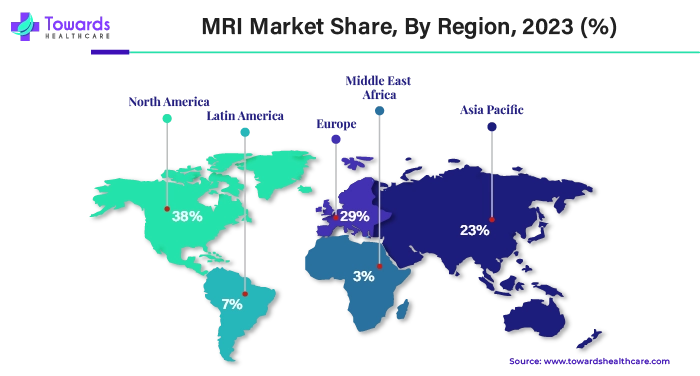
North America dominated the MRI market by 38% share in 2023. The introduction of hybrid MRI systems, the availability of universal health coverage in North America, the growing emphasis on early diagnosis, the solid foothold of major market players, and the clearly defined healthcare infrastructure are some of the major factors contributing to the market's growth. Additionally, it is anticipated that the market will increase as a result of the growing number of initiatives from the major players in the industry to provide novel products.
Due to the stronghold of major market players in the nation, the developed healthcare system, the growing initiatives of major market players, and the rising prevalence of ailments, including cardiovascular disorders, cancer, and neurological disorders, the U.S. owns a substantial part of the market. During the projected period, MRI market growth is anticipated to expand.
For instance,
The most frequent cancer diagnosis among women in the United States is breast cancer. About thirty percent of women's newly diagnosed cancers each year are breast cancers. In their lifetime, one in eight American women, or roughly 13% of all women, will get invasive breast cancer. In addition to 55,720 additional instances of DCIS, it was projected that 297,790 new cases of invasive breast cancer will be detected in American women in 2023. An anticipated 2,800 men will receive a diagnosis of aggressive breast cancer in 2023. The chance of breast cancer in a guy is 1 in 833 during his lifetime. The number of American women with a history of breast cancer is currently above 4 million.
One person dies from cardiovascular disease every 33 seconds, according to the CDC. In the US, an estimated 805,000 people suffer a heart attack annually. Of them, 200,000 involve persons who have already experienced a heart attack, and 605,000 are first-time heart attacks.
Asia Pacific is expected to grow at the fastest rate of 23% during the forecast period, mostly as a result of expanded R&D, improved healthcare infrastructure, an increase in the number of hospitals with cutting-edge medical facilities, an increase in healthcare reforms, and technological developments in the healthcare industry. The quick growth of the healthcare sector raised awareness of the benefits of early diagnosis and the availability of reasonably priced medical care. Countries like India, China, Japan, and North Korea are contributing to the growth of the MRI market in Asia Pacific. India is significantly contributing to the market’s growth through its efforts and technological advancements.
For instance,
By Architecture
By Field Strength
By Application
By End-use
By Region
Artificial intelligence (AI) is the study of creating computer systems that can perform tasks requiring human-like intelligence. Magnetic Resonance Imaging (MRI) is a method used to take detailed pictures of the inside of the body without surgery. MRI works by using powerful magnets and radio waves to look at the movement of protons in water within our tissues.
AI has greatly changed medical imaging by making it easier for doctors to accurately diagnose and plan treatments. With AI, technology has advanced to help detect diseases and analyze medical images more effectively. Machine learning (ML) and other AI tools are now improving the results of clinical tests and making diagnosis more precise. In radiology, especially in neuroradiology, AI tools help assess brain conditions by providing detailed measurements and automatically updating records. AI in medical imaging is a powerful approach that relies on understanding MRI, machine learning, and deep learning to create accurate and efficient diagnostic tools.
November 2024
November 2024
November 2024
March 2025